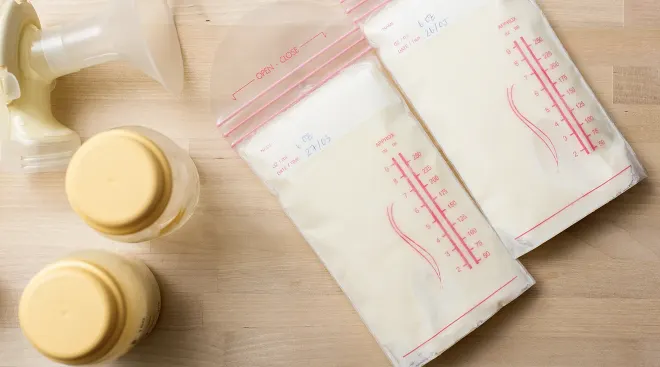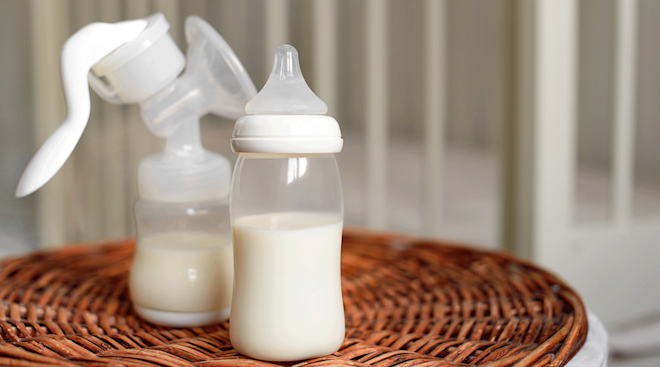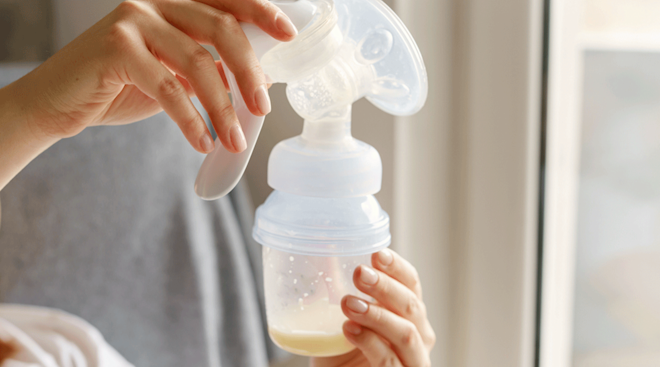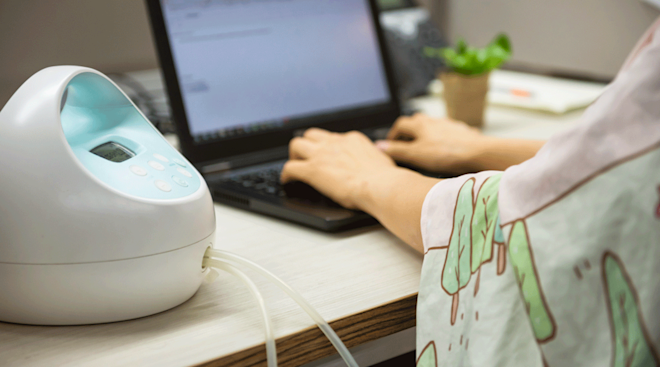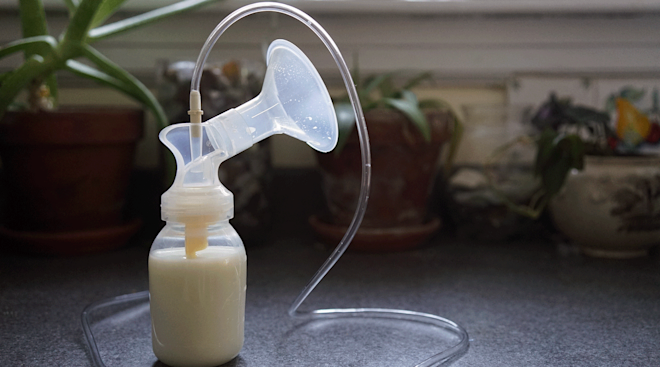Breastfeeding Let-Down 101: Everything You Should Know
If you’re breastfeeding or pumping, chances are you’ve felt the pins-and-needles sensation of the let-down reflex. But what exactly is a breastfeeding let-down and why does it happen? And what should you do if you have a painful let-down—or if it just isn’t working? Read on for expert advice.
The breastfeeding let-down reflex, aka oxytocin reflex or milk-ejection reflex, occurs when a surge of the hormone oxytocin triggers the milk ducts to contract and release milk for baby, says Jacque Ordner, IBCLC, BSN, RN, a lactation consultant, registered nurse and medical advisor at Motif Medical. This typically happens because of “nipple stimulation or thinking about or being close to baby,” she says.
Oxytocin is also known as the “love hormone,” notes Nicole Peluso, IBCLC, manager of lactation services and perinatal education at Aeroflow Breastpumps. “It’s released in many situations, including lovemaking, nurturing, childbirth and lactation,” she says.
There’s a wide range of “normal” when it comes to what breastfeeding let-down feels like, experts say. “Some women feel the let-down as a tingly, warm sensation, while others may feel sharp pain, and some feel nothing at all,” says Jaimie Zaki, IBCLC, MCPCD, a lactation consultant, doula and author. Ordner agrees: “Many women describe the let-down sensation as feeling a gentle tightening or squeezing within their breasts. Others feel a pins-and-needles type of sensation.” Moreover, it’s also completely fine and normal not to feel let-down at all.
The release of oxytocin can have a calming effect, says Peluso. “Women often feel a sense of calm or relaxation as the release happens,” she says. “Some may suddenly feel very sleepy due to the relaxing effects of oxytocin.” It’s important to note that while the effects of oxytocin are typically positive, a 2019 study suggests that as many as 9 percent of breastfeeding people experience D-MER, an abrupt, negative emotional response to let-down. If this sounds like you, know you’re not alone; be sure to reach out to your provider.
“Nipple stimulation is the most reliable way to trigger let-down,” says Ordner. “This can be from baby’s suckling, your hands or the use of a breast pump.” You can also encourage oxytocin release simply by thinking about baby, says Peluso. “Looking at baby, smelling an article of baby’s clothing, or listening to baby’s coos or noises can help raise oxytocin levels,” she says. “These activities can also help make pumping easier when mothers are at work or away from their babies.” Ordner suggests looking at pictures or videos of baby—you likely have no shortage of those!
To get oxytocin flowing, it’s also important to relax, notes Cleveland Clinic. (Easier said than done, we know.) Try stress-managing techniques like deep breathing or listening to calming music. Another popular tip is to get warm, since being cold can make your body tense up: Throw on a cozy blanket, or use a warm washcloth on your breasts to encourage milk to flow.
There are several reasons painful let-down can happen. Ordner says it could be due to clogged milk ducts—which can lead to breast inflammation, or mastitis—oversupply, nipple damage or an infection. Zaki says that painful let-down could also be related to Raynaud’s Phenomenon of the Nipple, a treatable condition that gets worse when you’re exposed to cold. “For others yet, past trauma can amplify the intensity of painful let-downs,” she adds. No matter what the reason for your painful let-down, make sure to reach out to an International Board Certified Lactation Consultant (IBCLC) if you need help.
Applying heat can help deal with painful let-down, says Peluso. Zaki adds: “Some women may find that warmth can help ease physical discomfort, while others may find cold compresses helpful.”
“If baby tends to cough, gulp, sputter or choke with let-down, you may have what’s often called an overactive let-down or forceful milk ejection reflex,” explains Ordner. Other signs include baby arching or stiffening—or milk sprays when baby comes off the breast, she adds. You may also notice excessive leaking from the side where baby’s not feeding, says La Leche League Canada. Here are a few tips that could help with an overactive let-down:
- Change positions. A laid-back or side-lying breastfeeding position can help baby better manage the flow of milk, says Ordner. Peluso also recommends an upright position. “[It can] make the milk flow against gravity,” she says.
- Hand-express. Sometimes, hand-expressing before latching baby can make it easier for baby to handle the milk flow, says Ordner.
- Take frequent breaks for burping. This can help slow your flow, says Peluso.
- Apply (a little) pressure. “Using your hand to gently press your breast toward your chest wall for some counter pressure can help slow the flow,” says Ordner.
Ordner says that overactive let-down gets better for many moms when their milk supply regulates, which often happens between six and 12 weeks postpartum. “If you think an oversupply is what’s causing your overactive let-down, an IBCLC can help you create a safe plan to manage it,” she adds.
The best way to encourage let-down is to spend as much time as possible skin-to-skin with baby before breastfeeding or pumping sessions, says Ordner. “Babywearing is a great way to keep baby close, whether skin-to-skin or not, and can also help boost oxytocin levels to aid let-down,” she says.
Rest assured that a slow let-down doesn’t necessarily mean you have low milk supply, according to experts. The important thing is that baby is gaining weight properly, as well as pooping and peeing enough, says Peluso. “If that’s all within an expected range, Mom can be assured she has enough milk,” she says. Check in with a lactation consultant if you’re unsure.
Frequently Asked Questions
What is a “phantom let-down”?
“Phantom let-down is the sense that you have a let-down of milk even after you’ve stopped lactating,” says Peluso. “It’s often triggered by the same thing that triggers an actual let-down—hearing baby cry or thinking about a person you love.” Should you worry about a phantom let-down? Typically no, says Ordner: “As long as there’s no nipple discharge or breast abnormalities associated with phantom let-down, there’s nothing to worry about.”
Why do I get a let-down headache and what can I do about it?
People can get headaches related to breastfeeding let-down because of postpartum hormonal fluctuations, says Ordner. She recommends eating a nutrient-dense diet, avoiding processed foods and staying hydrated. Making sure you have micronutrients such as magnesium and zinc can also be important, says Zaki.
Can you stop your let-down reflex?
If you feel a let-down coming on at an inconvenient time, experts recommend using your wrist or forearm to apply firm pressure to your breast for a few seconds to slow the response.
When does let-down stop?
The breastfeeding let-down reflex starts to fade as you wean baby, and stops altogether once milk production tapers down, says Ordner. “I don’t think there’s good science on when it stops,” adds Peluso. “Let-down will happen for the whole time that you breastfeed, but your sensations of let-down will usually diminish the longer you feed.” When your period returns, the let-down sensation tends to diminish the most, she says.
Knowing the facts about your let-down reflex can help you figure out what to do if something goes wrong, such as if your let-down is painful. In the meantime, let the milk flow and enjoy all the benefits oxytocin can provide!
Please note: The Bump and the materials and information it contains are not intended to, and do not constitute, medical or other health advice or diagnosis and should not be used as such. You should always consult with a qualified physician or health professional about your specific circumstances.
Plus, more from The Bump:
Jacque Ordner, IBCLC, BSN, RN, RLC, is a lactation consultant, registered nurse and medical advisor at Motif Medical.
Nicole Peluso, IBCLC, CD, CAHPE, is the manager of lactation services and perinatal education at Aeroflow Breastpumps. She is also a parenting educator certified by Attachment Parenting International, a La Leche League Leader, and a birth and postpartum doula.
Jaimie Zaki, IBCLC, MCPCD, is a lactation consultant, doula and author in Wichita Falls, Texas.
World Health Organization, Infant and Young Child Feeding: Model Chapter for Textbooks for Medical Students and Allied Health Professionals, 2009
Breastfeeding Medicine, Dysphoric Milk Ejection Reflex: A Descriptive Study, November 2019
Cleveland Clinic, What to Know About the Breastfeeding Let-Down, September 2023
Pediatrics (American Academy of Pediatrics), Raynaud’s Phenomenon of the Nipple: A Treatable Cause of Painful Breastfeeding, April 2004
La Leche League Canada, Oversupply and Forceful Letdown (Milk Ejection Reflex), November 2022
Learn how we ensure the accuracy of our content through our editorial and medical review process.
Navigate forward to interact with the calendar and select a date. Press the question mark key to get the keyboard shortcuts for changing dates.

































